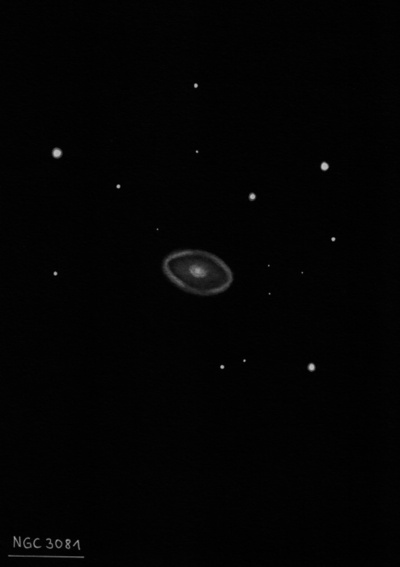
NGC 3081 is a barred lenticular ring galaxy in the constellation of Hydra. NGC 3081 is located about 85 million light-years away from Earth, which means, given its apparent dimensions, that NGC 3081 is approximately 60,000 light-years across. It is a type II Seyfert galaxy, characterised by its bright nucleus. It was discovered by William Herschel on 21 December 1786. NGC 3081 is seen nearly face-on. The galaxy's barred spiral centre is surrounded by a bright loop known as a resonance ring. This ring is full of bright clusters and bursts of new star formation, and frames the supermassive black hole thought to be lurking within NGC 3081—which glows brightly as it gobbles up infalling material.
400/500mm - 17.5" (3/28/87): moderately bright, fairly small, very bright compact core, possible stellar nucleus. The fainter oval halo is extended E-W.
900/1200mm - 48" (4/18/15): this beautiful resonant ring galaxy was viewed at 488x and 610x. It was very sharply concentrated with a very bright, roundish core (slightly oval at 610x) core that gradually increased to a stellar nucleus. The surface brightness dropped significantly in the inner halo, but then brightened at the edge to a well defined oval ring, extending 5:3 WSW-ENE, 1.3'x0.8'. The ring was fairly narrow and brightened slightly at the ends of the major axis (southwest and northeast ends). This was a very distinctive object! The core itself contains a barred spiral ring, but this feature was not seen.
48" (5/3/19): at 488x; NGC 3081 is one of the most distinctive resonant ring galaxies; it was sharply concentrated with an extremely bright core that appeared roundish, moderately large, gradually intensified further towards the center. The slightly elongated elongated halo displayed a noticeable edge brightening forming a fairly low contrast ring.